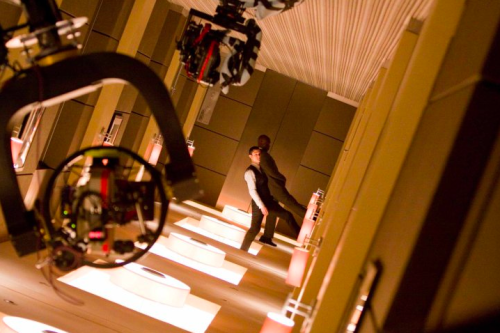 Last night I watched Inception on Blu-ray, and when it was done, watched all the little "featurettes" about how they achieved the effects, particularly those involving Arthur's action sequences in the hotel when gravity was misbehaving. (Those are just as breathtakingly amazing as ever.) The trick to how they did them is simpler than I thought: two identical sets, one built horizontally on rolling gimbals, one built vertically. (I couldn't figure out how they could combine wire-work with the rotating set approach, but two sets makes it all make sense.)
Last night I watched Inception on Blu-ray, and when it was done, watched all the little "featurettes" about how they achieved the effects, particularly those involving Arthur's action sequences in the hotel when gravity was misbehaving. (Those are just as breathtakingly amazing as ever.) The trick to how they did them is simpler than I thought: two identical sets, one built horizontally on rolling gimbals, one built vertically. (I couldn't figure out how they could combine wire-work with the rotating set approach, but two sets makes it all make sense.)The "how they did it" footage actually shows you the tremendous amount of construction required. In essence, they built an entire hundred-foot-long hotel corridor along with an adjoining room, twice. The first time, on an airplane-sized set of rotating hoops laced with struts and mounted on spinning wheels with a complex set of machinery to ensure it all rotated perfectly. The second time, hanging down the side of a tall support tower. Someone went to great effort to ensure that both of them matched perfectly, down to every detail of the carpeting and wallpaper and lighting. Then they had to add the filming lighting and camera mounting and movement to each, to say nothing of the incredible fight choreography for the action sequences that happened in them.
The other featurettes describe a dozen other similar feats of engineering. The mountain fortress was built in full in Calgary (though out of plywood, not concrete), and then blown up. A 45' tall model of it, and the mountain it was on, was also built in a parking lot, and blown up... twice. An entire locomotive was built on the back of a modified tractor-trailer and then driven down an L.A. street smashing cars. A hotel bar was built on a tilting platform. A set of Penrose stairs was built in a vacant office building, along with special rigs for the camera movement. A Japanese castle was built, then destroyed, then flooded by dozens of air cannons mounted to water tanks. And so on.
And that's just a few scenes from one movie. If you think of all the stuff that Hollywood builds and then tears down or blows up, it's mind-boggling to consider the amount of industry involved. We are astonished at the idea of building the Great Pyramids, but part of that is the technology available. We are also impressed by the skyscrapers and vast bridges and other great works of civil engineering.
Admittedly, what Hollywood builds isn't built to the same standards of durability -- though in many cases, the engineering challenges they face, though very different, are just as impressive. (Making a hotel corridor they can rotate at varying speeds is certainly comparably challenging to making one that is efficient at managing heating and cooling). But when you add up all the challenges involved in one big blockbuster, let alone the dozens Hollywood cranks out in a year, they're clearly exerting an amount of effort and talent that is amazing.
I am a big fan of the movies and thus very glad they do what they do. But I also feel a little bad about how we invest such an incredible amount of energy in structures that will be torn down a month later, while elsewhere, schools, hospitals, shelters, and homes suffer neglect. I wonder, would it be possible for Hollywood to come up with a way to build new buildings and then leave them behind to be put to some use?
And I know the answer is, doing that would cost not just a little more, but tons more, because of all the difficulties of building to code, building things to last, building them on location, and building them to suit two purposes, not just one. So, no, they couldn't really do that. Maybe once in a very rare while they could if the movie's needs happen to align well with something that someone needs in a spot that's convenient for filming, but it would be very rare.
I wish I could see a way that somehow, all that tremendous amount of industry could be tapped into and given a second purpose. I'm not saying that we shouldn't be making movies, or that we shouldn't be building sets we're going to blow up or tear down. But wouldn't it be nice if some more good could come of it?

 RealTime and RTC
RealTime and RTC Prism
Prism Uncreated
Uncreated Bloodweavers
Bloodweavers Foulspawner's Legacy
Foulspawner's Legacy Lusternia
Lusternia
1 comment:
I was listening to an interview on NPR with people who work on location scouting and movie sets. One described his work as "Planning a complete wedding for 200 people, every day, in a different location that you sometimes see only a few hours before everyone has to show up." Having been an extra om a movie set, the amount of man-hours involved and the amount of waste of those man-hours is ASTONISHING. People in filmmaking treat it as completely normal that work for 200 people stops dead for 20 minutes while one lighting guy checks a meter and re-aims a spot, then they shoot for two minutes, then stop again for 10 minutes while the sound guy figures out a different problem.
Post a Comment